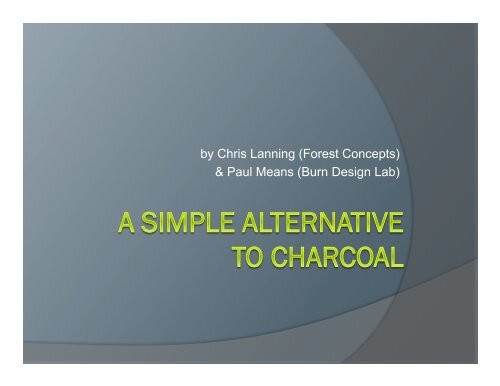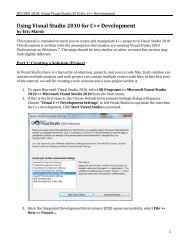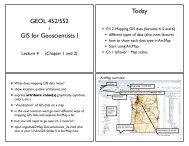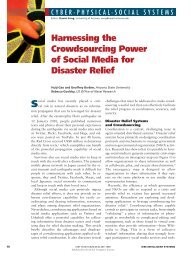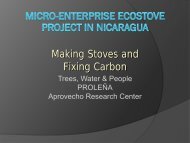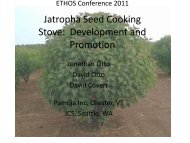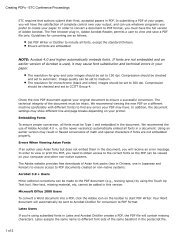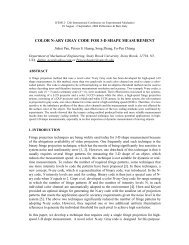A Simple Alternative to Charcoal
A Simple Alternative to Charcoal
A Simple Alternative to Charcoal
You also want an ePaper? Increase the reach of your titles
YUMPU automatically turns print PDFs into web optimized ePapers that Google loves.
y Chris Lanning (Forest Concepts)<br />
& Paul Means (Burn Design Lab)
A <strong>Simple</strong> <strong>Alternative</strong>….<br />
Background<br />
Issues with <strong>Charcoal</strong><br />
<strong>Charcoal</strong> and <strong>Alternative</strong> Value Chains<br />
Size Reduction<br />
Drying<br />
Transport Considerations<br />
Fuel Utilization<br />
Next Steps<br />
1/27/2013 2
A <strong>Simple</strong> <strong>Alternative</strong> - Background<br />
1/27/2013<br />
<strong>Charcoal</strong> Use<br />
Sub-Saharan Africa<br />
○ 11% of population use<br />
charcoal as primary fuel.<br />
○ 69% use woody<br />
biomass.<br />
Kenya, 30% of urban<br />
dwellers use charcoal as<br />
primary fuel<br />
Uganda, 60% of urban<br />
population use charcoal<br />
3
A <strong>Simple</strong> <strong>Alternative</strong> - Background<br />
1/27/2013<br />
Advantages <strong>to</strong> <strong>Charcoal</strong><br />
Employment<br />
○ The estimated charcoal producers in<br />
Kenya is 200,000.<br />
○ Approximately 500,000 people engage<br />
in downstream-processing and trade.<br />
○ the economic value of the charcoal<br />
industry in SSA may exceed US$12<br />
billion by 2030, employing almost 12<br />
million people.<br />
Clean burning – low<br />
particulate emissions<br />
Very convenient<br />
Fuel Conservation – user can<br />
save unused fuel.<br />
Low capital production<br />
4
Issues with <strong>Charcoal</strong><br />
1/27/2013<br />
Environmental Impact –<br />
charcoal made from live<br />
trees (Deforestation rate<br />
in Sub-Saharan Africa<br />
~0.8%)<br />
In Kenya 2006, biomass<br />
demand was estimated at<br />
38.1 million <strong>to</strong>nnes<br />
against a sustainable<br />
supply of 15.4 million<br />
<strong>to</strong>nnes, creating a<br />
demand-supply deficit of<br />
60 percent.<br />
High CO emissions from<br />
burning charcoal<br />
Low production efficiency<br />
5
System Efficiency – Traditional<br />
<strong>Charcoal</strong> Production & Use<br />
100%<br />
90%<br />
80%<br />
70%<br />
60%<br />
50%<br />
40%<br />
30%<br />
20%<br />
10%<br />
0%<br />
<strong>Charcoal</strong><br />
Production<br />
Efficiency = 15%<br />
Efficiency = energy<br />
output / energy input<br />
<strong>Charcoal</strong> S<strong>to</strong>ve<br />
Efficiency = 25% Net System<br />
Efficiency = 4%<br />
Wood Energy <strong>Charcoal</strong> Energy Cooking Energy<br />
1/27/2013 6
System Efficiency – Improved<br />
<strong>Charcoal</strong> Production & Use<br />
100%<br />
90%<br />
80%<br />
70%<br />
60%<br />
50%<br />
40%<br />
30%<br />
20%<br />
10%<br />
0%<br />
<strong>Charcoal</strong><br />
Production<br />
Efficiency = 25%<br />
Efficiency = energy<br />
output / energy input<br />
<strong>Charcoal</strong> S<strong>to</strong>ve<br />
Efficiency = 45%<br />
Net System<br />
Efficiency = 11.5%<br />
Wood Energy <strong>Charcoal</strong> Energy Cooking Energy<br />
1/27/2013 7
Value Chains<br />
1/27/2013<br />
<strong>Charcoal</strong><br />
Wood<br />
Production<br />
• High<br />
Consumption<br />
<strong>Charcoal</strong><br />
Production<br />
• Low<br />
Efficiency<br />
• Low Capital<br />
Transport<br />
• High Energy<br />
Density<br />
Wholesale /<br />
Retail<br />
• Well<br />
Established<br />
Use<br />
• Variable<br />
Efficiency<br />
• Low<br />
Particulate<br />
• High CO<br />
8
Value Chains<br />
1/27/2013<br />
<strong>Alternative</strong> – sized & dried biomass<br />
Wood<br />
Production<br />
• Low<br />
Consumption<br />
Size<br />
Reduction &<br />
Drying<br />
• High<br />
Efficiency<br />
• Moderate<br />
Capital<br />
Transport<br />
• Moderate<br />
Energy<br />
Density<br />
Wholesale /<br />
Retail<br />
• Not<br />
Established<br />
Consumption<br />
• High<br />
Efficiency<br />
• Low<br />
Emissions<br />
9
System Efficiency –Sized & Dry Biomass<br />
Production & Use<br />
100%<br />
90%<br />
80%<br />
70%<br />
60%<br />
50%<br />
40%<br />
30%<br />
20%<br />
10%<br />
0%<br />
Sizing & Drying<br />
Efficiency = 75+%<br />
Micro-Gasifier S<strong>to</strong>ve<br />
Efficiency = 40+%<br />
Net System<br />
Efficiency = 30+%<br />
Wood Energy S & D Wood Energy Cooking Energy<br />
3 Fold increase over improved charcoal system efficiency<br />
8 fold increase over traditional charcoal system efficiency<br />
1/27/2013 10
Size Reduction (Comminution)<br />
Saw<br />
Grinder<br />
Shredder<br />
Chipper<br />
Knife Mill<br />
Lathe<br />
Crumbler<br />
…<br />
1/27/2013 11
Size Reduction (Comminution)<br />
Grinder<br />
Mech. Energy (kW-hr/t*)<br />
○ 85-420<br />
Benefit<br />
○ Can be HUGE 100 t/hr<br />
○ Many configurations<br />
○ Very <strong>to</strong>lerant of feeds<strong>to</strong>ck impurities<br />
Limitation<br />
○ Material handling challenges<br />
Stringy, “broom ends”, non-flowable<br />
○ Sensitive <strong>to</strong> moisture content<br />
Energy increases with mc<br />
○ Minimum piece size<br />
Energy increases very quickly as size decreases<br />
○ Wide piece size distribution<br />
* t= 1000 oven dry kg mass<br />
1/27/2013 12
Size Reduction (Comminution)<br />
Chipper / Knife Mill<br />
Mech. Energy (kW-hr/t)<br />
○ 25-140<br />
Benefit<br />
○ More Efficient<br />
○ Many configurations<br />
Limitation<br />
○ Material handling<br />
Minimal flowability<br />
○ Grit in<strong>to</strong>lerance<br />
Grit dulls knives quickly<br />
○ Minimum piece size<br />
Limitation <strong>to</strong> minimum piece size<br />
○ Moderate piece size distribution<br />
Material pic<br />
1/27/2013 13
Size Reduction (Comminution)<br />
Auger Chipper<br />
Mech. Energy (kW-hr/t)<br />
○ 25-140<br />
Benefit<br />
○ Efficient<br />
○ Moisture <strong>to</strong>lerance<br />
Limitation<br />
Effective over wide moisture range<br />
○ Material handling<br />
Minimal flowability<br />
○ Grit in<strong>to</strong>lerance<br />
○ Product size range<br />
Larger particles<br />
○ Wide piece size distribution<br />
1/27/2013 14
Size Reduction (Comminution)<br />
Lathe<br />
Mech. Energy (kW-hr/t)<br />
○ 2-6<br />
Benefit<br />
○ Very Efficient<br />
○ Uniform product<br />
○ Transportable<br />
Limitation<br />
○ Veneer?<br />
Easily rolls or stacks<br />
Intermediate product<br />
○ Grit <strong>to</strong>lerance<br />
Grit wears blade<br />
○ Out of round material<br />
Lost yield, can be difficult <strong>to</strong> start<br />
1/27/2013 15
Size Reduction (Comminution)<br />
Crumbler®<br />
Mech. Energy (kW-hr/t)<br />
○ 15-55<br />
Benefit<br />
○ Very efficient<br />
○ Narrow piece size distribution<br />
○ Material handling<br />
Highly flowable<br />
○ Moisture <strong>to</strong>lerance<br />
Limitation<br />
More efficient with high mc<br />
○ Grit in<strong>to</strong>lerance<br />
○ Size range<br />
16 mm maximum in 1 dimension<br />
○ Second stage size reduction<br />
1/27/2013 16
Size Reduction (Comminution)<br />
Particle shape consideration, Flowability<br />
Pellets<br />
Ground pellet furnish<br />
(in front of glass)<br />
Pouring<br />
Glass<br />
Crumbles®<br />
4mm Particles<br />
1/27/2013 17
Size Reduction (Comminution)<br />
Summary<br />
kW-hr/t<br />
300<br />
250<br />
200<br />
150<br />
100<br />
50<br />
0<br />
Mechanical Energy<br />
Grinder Chipper Screw<br />
Chipper<br />
Particle Size and Shape Matter<br />
Lathe Crumbler®<br />
1/27/2013 18
Drying<br />
Types<br />
Rotary drum<br />
Fluidized bed<br />
Belt<br />
Deep bed (grain)<br />
Tarp<br />
Fuels<br />
Fossil fuel<br />
Electric (very limited)<br />
Wood<br />
Other biomass<br />
Sun<br />
1/27/2013 19
Drying<br />
Types<br />
Rotary drum<br />
Fluidized bed<br />
Belt<br />
Deep bed (grain)<br />
Tarp<br />
Fuels<br />
Fossil fuel<br />
Electric (very limited)<br />
Wood<br />
Other biomass<br />
Sun<br />
1/27/2013 20
Transport Considerations<br />
Energy Density<br />
100%<br />
90%<br />
80%<br />
70%<br />
60%<br />
50%<br />
40%<br />
30%<br />
20%<br />
10%<br />
0%<br />
Relative Energy Density<br />
(lower heating value / kg)<br />
<strong>Charcoal</strong> @<br />
3% Moisture<br />
Hardwood @<br />
10% Moisture<br />
Hardwood @<br />
40% Moisture<br />
1/27/2013 21
Transport Considerations<br />
Hauling Cost<br />
Impact due <strong>to</strong><br />
lower net heating<br />
value for raw<br />
biomass.<br />
3.00<br />
2.50<br />
2.00<br />
1.50<br />
1.00<br />
0.50<br />
0.00<br />
<strong>Charcoal</strong> @ 3%<br />
Moisture<br />
Haul Cost Multiplier<br />
Hardwood @<br />
10% Moisture<br />
Hardwood @<br />
40% Moisture<br />
1/27/2013 22
Transport Considerations<br />
RElative Haul Distance<br />
160%<br />
140%<br />
120%<br />
100%<br />
80%<br />
60%<br />
40%<br />
20%<br />
0%<br />
Forest Area Required and Relative Haul Distance<br />
Forest Required<br />
<strong>to</strong> Support<br />
Traditional<br />
<strong>Charcoal</strong><br />
Forest <strong>to</strong><br />
support<br />
Improved<br />
<strong>Charcoal</strong><br />
Forest for<br />
<strong>Alternative</strong><br />
0 1 2 3 4<br />
1/27/2013 23
Transportation Considerations – cont.<br />
Net Hauling Cost =<br />
Energy Density * Haul<br />
Distance<br />
100%<br />
1/27/2013 24<br />
90%<br />
80%<br />
70%<br />
60%<br />
50%<br />
40%<br />
30%<br />
20%<br />
10%<br />
0%<br />
Relative Net Hauling Cost<br />
Traditional<br />
<strong>Charcoal</strong><br />
Improved<br />
<strong>Charcoal</strong><br />
<strong>Alternative</strong>
Fuel Utilization<br />
Micro-Gasifiers get<br />
their day in the sun..<br />
Efficiency = 40+%<br />
Low CO and PM2.5<br />
emissions<br />
Well suited for<br />
standardized dry<br />
chunky fuel.<br />
1/27/2013 25
Conclusions<br />
The charcoal value chain is very<br />
inefficient.<br />
Size reduction & drying of woody<br />
biomass, combined with microgasification<br />
can displace charcoal as a<br />
fuel for urban dwellers.<br />
The new value chain, if developed,<br />
would<br />
reduce forest usage by 66 <strong>to</strong> 87%<br />
Reduce indoor air pollution.<br />
1/27/2013 26
Next Steps<br />
Comparative Economic Analysis of Value<br />
Chains<br />
Development of right sized equipment for size<br />
reduction.<br />
Evaluation of alternative drying technologies<br />
Optimization of the fuel for:<br />
Low capital cost<br />
Low purchased energy costs<br />
S<strong>to</strong>rage, handling, & combustion characteristics<br />
S<strong>to</strong>ve design<br />
Pilot the <strong>Alternative</strong> (Kenya S<strong>to</strong>ve)<br />
1/27/2013 27
Thank You!<br />
Questions??<br />
Chris Lanning<br />
clanning@forestconcepts.com<br />
Paul Means<br />
paul@burndesignlab.org<br />
1/27/2013 28


